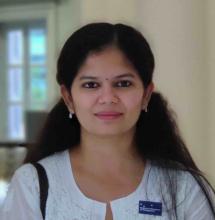Dr. Gowri did her B.Tech in Biotechnology from PSG College of Technology, Coimbatore in 2012. She did her summer fellowship and B.Tech final year project at Christian Medical College (CMC), Vellore where she worked on the effects of nutrition on the gut microbiota and intestinal health in rural children. She then pursued her PhD and MSc (Engineering) in the Department of Bioengineering at the Indian Institute of Science (IISc), Bangalore. During her PhD, she developed organotypic models for the study of breast cancer metastasis. This involved the development of synthetic matrices that mimicked the mechanical properties of the cancer tissue and its stroma and was successfully able to adopt this for the growth of primary breast cancer tissues for personalized medicine. She graduated in 2018 and worked briefly as a guest faculty at PSG Tech. She then joined National University of Singapore (NUS) in 2019 and worked in developing morphogenetic models for the development of intrahepatic bile ducts and developed it into an assay to test developmental toxins. She headed the team of researchers and developed a liver-on-a-chip model for mechanistic understand of non-alcoholic steatohepatitis (NASH) and drug testing. She joined the School of Biomedical Engineering as an Assistant Professor from February 2023.
Our Tissue Repair and Regeneration Lab is focussed on developing interdisciplinary approaches to understand and facilitate regeneration in chronic diseases, specifically chronic liver diseases (CLD) and chronic wounds. in CLD, We are particularly interested in fatty liver disease. With an increasing prevalence of co-risk factors such as diabetes and obesity, fatty liver diseases (FLD) pose and emerging health crisis and a major economic burden to the world and particularly, India. Our approaches include the following
- Engineering organotypic models for liver with adult liver stem cells derived from Indian donors
- Biomaterials based strategies to model and mimic liver tissue microenvironment at various stages of CLD
- Integration of liver microtissue with other organs such as the gut and cardiac tissue using organs-on-chip approaches to study the cross talk between them
These approaches will be used to understand liver regeneration under normal and pathological conditions to identify faults during regeneration and test various natural and pharmacological agents that can promote repair and regeneration.
Google Scholar: https://scholar.google.com/citations?user=c9B13icAAAAJ&hl=en
-
Karnawat, K., Parthasarathy, R., Sakhrie, M., Karthik, H., Krishna, K. V., & Balachander, G. M. (2024). Building in vitro models for mechanistic understanding of liver regeneration in chronic liver diseases. Journal of materials chemistry. B, 12(32), 7669–7691. https://doi.org/10.1039/d4tb00738g
-
Balachander, G. M.* #, Nilawar, S.*, (*equal contribution) Meka, S. R. K., Ghosh, L. D., & Chatterjee, K# (#equal correspondence)(2024). Unravelling microRNA regulation and miRNA-mRNA regulatory networks in osteogenesis driven by 3D nanotopographical cues. Biomaterials science, 12(4), 978–989. https://doi.org/10.1039/d3bm01597a
-
Septiana, W. L., Ayudyasari, W., Gunardi, H., Pawitan, J. A., Balachander, G. M., Yu, H., & Antarianto, R. D. (2023). Liver organoids cocultured on decellularized native liver scaffolds as a bridging therapy improves survival from liver failure in rabbits. In vitro cellular & developmental biology. Animal, 59(10), 747–763. https://doi.org/10.1007/s11626-023-00817-8
-
Zixuan Zhao, Xinyi Chen, Anna M Dowbaj, Aleksandra Sljukic, Kaitlin Bratlie, Luda Lin, Eliza Li Shan Fong, Gowri Manohari Balachander, Zhaowei Chen, Alice Soragni, Meritxell Huch, Yi Arial Zeng, Qun Wang, Hanry Yu. organoids. Nature Reviews Methods Primers 2022;2;94. doi:doi.org/10.1038/s43586-022-00174-y
-
Balachander GM*, Kotcherlakota R* (*equal contribution), Nayak B, Kedaria D, Rangarajan A, K. Chatterjee. 3D Tumor Models for Breast Cancer: Whither We Are and What We Need. ACS Biomater. Sci. Eng., 2021, 7, 3470–3486.
doi: 10.1021/acsbiomaterials.1c00230 -
Gupta K, Ng IC, Balachander GM, Nguyen BP, Tucker-Kellogg L, Low BC, et al. Bile canaliculi contract autonomously by releasing calcium into hepatocytes via mechanosensitive calcium channel. Biomaterials 2020;259:120283. doi:10.1016/j.biomaterials.2020.120283.
-
Balamurugan R, Pugazhendhi S, Balachander GM, Dharmalingam T, Mortimer EK, Gopalsamy GL, et al. Effect of Native and Acetylated Dietary Resistant Starches on Intestinal Fermentative Capacity of Normal and Stunted Children in Southern India. Int J Environ Res Public Health 2019;16:3922. doi:10.3390/ijerph16203922.
-
De T, Goyal S, Balachander GM, Chatterjee K, Kumar P, Babu K. G, et al. A Novel Ex Vivo System Using 3D Polymer Scaffold to Culture Circulating Tumor Cells from Breast Cancer Patients Exhibits Dynamic E-M Phenotypes. J Clin Med 2019;8:1473. doi:10.3390/jcm8091473.
-
Huang X, Lee F, Teng Y, Lingam CB, Chen Z, Sun M, Song Z, Balachander GM, et al. Sequential drug delivery for liver diseases. Adv Drug Deliv Rev 2019;149–150:72–84. doi:10.1016/j.addr.2019.11.001.
-
Nayak B*, Balachander GM* (*equal contributions), Manjunath S, Rangarajan A, Chatterjee K. Tissue mimetic 3D scaffold for breast tumor-derived organoid culture toward personalized chemotherapy. Colloids Surfaces B Biointerfaces 2019;180:334– 43. doi:10.1016/j.colsurfb.2019.04.056.
-
Balachander GM, Talukdar PM, Debnath M, Rangarajan A, Chatterjee K. Inflammatory Role of Cancer-Associated Fibroblasts in Invasive Breast Tumors Revealed Using a Fibrous Polymer Scaffold. ACS Appl Mater Interfaces 2018;10:33814–26. doi:10.1021/acsami.8b07609.
-
Balachander GM, Rajashekar B, M Sarashetti P, Rangarajan A, Chatterjee K. MiRNomics Reveals Breast Cancer Cells Cultured on 3D Scaffolds Better Mimic Tumors in Vivo than Conventional 2D Culture. ACS Biomater Sci Eng 2018;4:116–27. doi:10.1021/acsbiomaterials.7b00694.
-
Balachander GM, Balaji SA, Rangarajan A, Chatterjee K. Enhanced Metastatic Potential in a 3D Tissue Scaffold toward a Comprehensive in Vitro Model for Breast Cancer Metastasis. ACS Appl Mater Interfaces 2015;7:27810–22. doi:10.1021/acsami.5b09064. Correction doi: https://doi.org/10.1021/acsami.1c14650
List of book chapters:
- Yu H, Chong SK, Hassanbhai AM, Teng Y, Balachander G, Muthukumaran P, et al. Principles of bioreactor design for tissue engineering. Princ. Tissue Eng., Elsevier; 2020, p. 179–203. doi:10.1016/B978-0-12-818422-6.00012-5.
BM101: Introduction to Biomedical Engineering
BM205: Transport Processes
BM421: Biotransport Processes
BM501: BioMEMS and Biosensors
